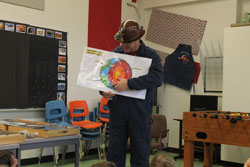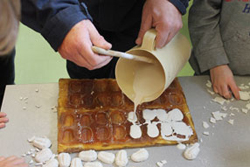MAMMALS:
This workshop is ment for the kids from kindergarten to 7th grade elementary schools for Ontario students and also for 1st secondary students in Québec. The duration of this workshop may vary from one (1) hour to one hour and a half (1½), and is given to a group of 25 students (more or less). Lots of samples such as: furs, skulls, droppings, etc. are on display in the room where the workshop takes place. The first part is a hosted presentation of an approximate of twenty (20) minutes, period of time formed by exchanges and discussions on the mammal's subject. Backed up with an audio-visual material, the host is disguised in the «bearded trapper», role manages the workshop in a very dynamic approach.
The second part which last about forty (40) minutes is devoted to team discoveries of sample kits of twelve (12) different species of mammals. A questionnaire is given to each team, and at the end the correct answers are given by the host.
The reviewed themes seen in this first workshop are:
- Mammals, different features;
- Feeding;
- Metabolism;
- Habits and way of living.
Here's a detailed listing of different samples brought in the workshop:
- Furs and skulls: black bear, moose, caribou, Virginia deer, raccoon, red fox, coyote, beaver, wolf, lynx, fisher, mink, otter, marten, weasel, squirrel, glutton, cougar, skunk, and more!
- Droppings: black bear, raccoon, porcupine, Virginia deer; and also some small species of mammals preserved in jars such as: shrew, field mouse, mouse, bats, etc.
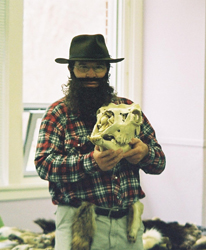
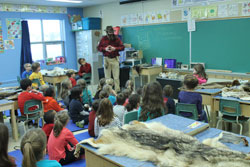
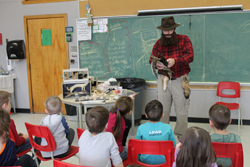
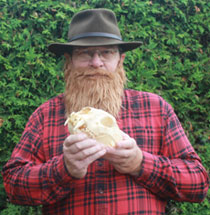
INSECTS
This specific workshop is very well suited for kids from kindergarten up to 7th graders elementary students of Ontario and also until first secondary students in Québec. The duration varies from one (1) hour up to one hour and a half (1½) for a variable group of an average 25 students for example. The first part is hosted inside the classroom and starts with an account by a disguised host. He works out with the kids on special features of different insects. With detailed drawings made by the host himself, this one summarizes the major species of insects with the common and well known categories.
Later in this workshop, live insects are shown to the students as well as pinned ones mounted on several display show boxes. There are also many spiders, either native ones or also more exotic species too. Posters and highly specialized books on the matter are also used with the theory part of the workshop which takes about twenty (20) minutes or so!
The second part is hosted outside in nature if the weather's conditions are good of course! Capture jars and nets are provided for the students who again teamed up will we go out hunting and capture game of insects. At first the host summarizes the students on the right way to have a good catch of bugs. Then later on, the kids bring their findings in a previously prepared glass living mini echo-system. A few minutes are required here for them to identify their catches. The duration of this part takes about thirty (30) minutes or less if time's not too abundant.
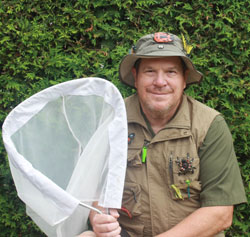

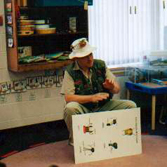
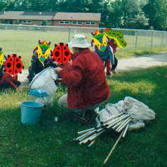
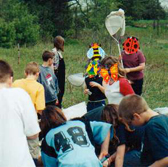
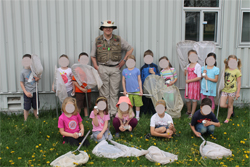
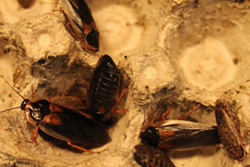
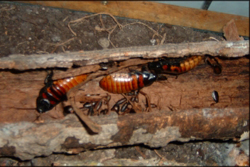
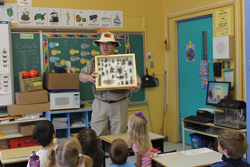
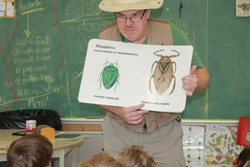
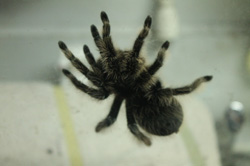
FOSSILS, ROCKS AND MINERALS
This specific workshop is intended for kindergarten kids up to 7th grade elementary students for Ontario and also until first secondary classes in Québec. Allowed time for presentation of this workshop is about one (1) hour for a group or class of 25 students for example. The host is disguised as an Abitibi miner, with a lighted safety helmet and a deep blue working suit. The first part of this workshop begins with a statement on the earth's historic formation; on rocks, fossils and minerals we could find here and there. More to it, there's also drawings showing students such phenomenal earth's never-ending natural events such as: volcanoes, rock's erosion, earthquakes, and also tectonics plates movements which are responsible for continents slow drifting away from each others.
Note: A major part of the pedagogic material here is shown mostly in photographs.
With the help of most common types of stones, students will learn the difference between the types of rocks so called: fusion ones, metamorphic and sediment ones. A vast collection of rocks, fossils and minerals is on display in the classroom. This ends the theoretical part of the workshop.
The second part here consists of a genuine demonstration of a casting made of plaster «de Paris». With the help of a pre-shaped mold, the host pours plaster in his «negative» mold and once dried up, he obtains a «positive» reproduction of a 300 million years old type of fossil called an: «Trilobite». Each student receives a sample which will give them a little souvenir of the daily activity. Furthermore, rocks specimens could also be won by a draught among participants of this workshop.

